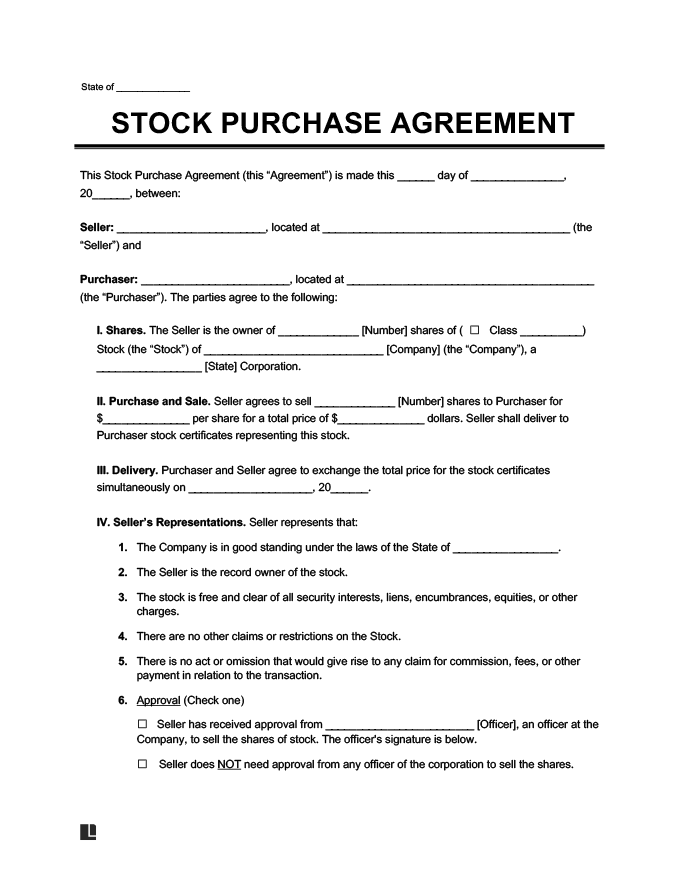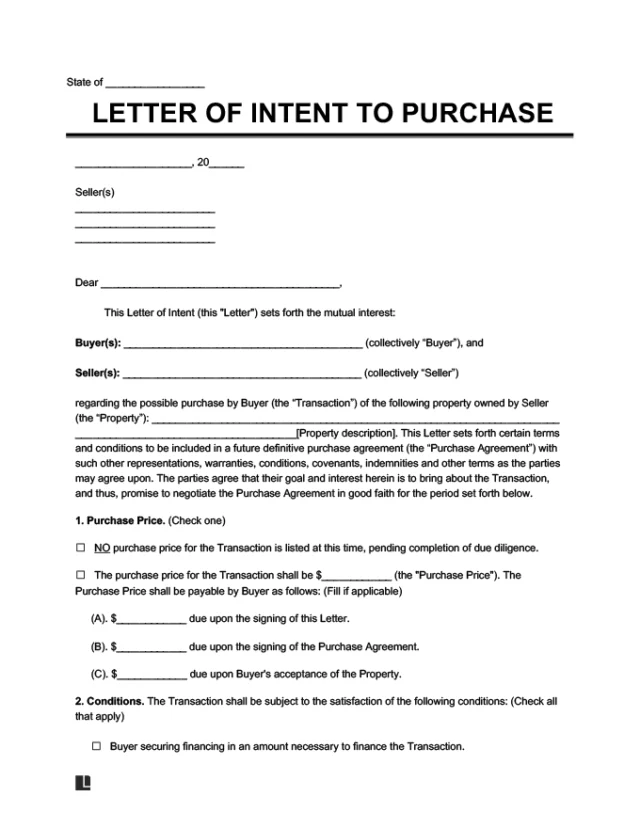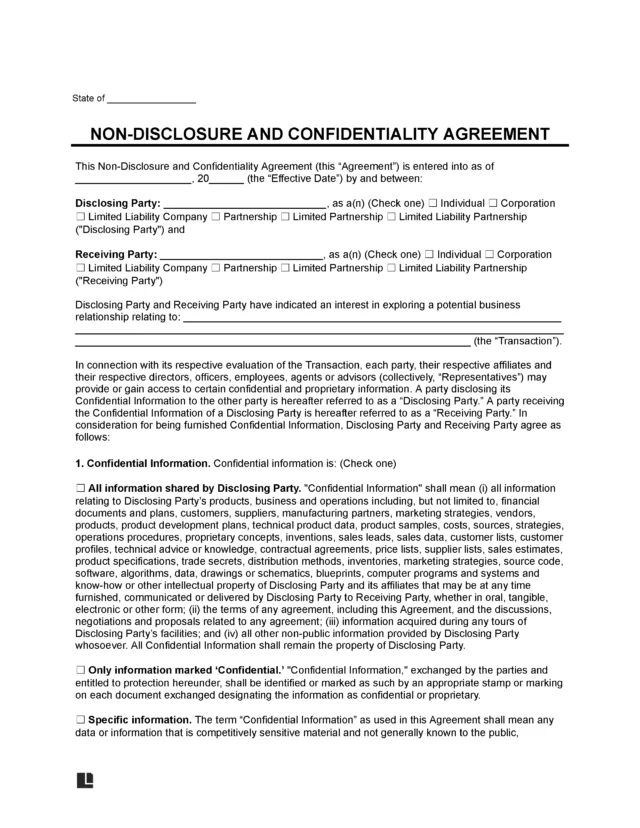A stock purchase agreement (SPA) is a legal document outlining the terms of a buyer and seller’s transaction of company shares.
What Is a Stock Purchase Agreement?
A stock purchase agreement or share purchase agreement is a contract a buyer and seller enter to solidify the transfer of company stock.
Most commonly, this agreement is between the company’s shareholders and an external party. The external party may purchase stock from the company or sell it back to the shareholders. Alternatively, this contract may be between two external parties looking to transact company stock that one of them owns.
This agreement strives to protect both parties since it lays out the sale of company shares, their price, and which party is obtaining them.
Fast Facts About Stock Purchases
- Companies also refer to stocks as “equities.”
- Buying shares makes you a partial owner of the company.
- Partial ownership through owning stocks may give you voting rights for business decisions.
- Stocks usually trade on exchanges like the Nasdaq Composite or the New York Stock Exchange (NYSE), but companies can sell stocks privately.
Types of Stocks
Purchasing stocks privately typically refers to acquiring shares in private companies or obtaining shares from existing shareholders in a private transaction. Here are the types of stocks someone can purchase privately:
- Common stock: Common stock represents ownership in the company. Holders of this stock often have voting rights. They may also receive dividends, shares of the company’s profits that vary based on company performance.
- Preferred stock: Preferred stock provides a combination of debt and equity features. Preferred stockholders usually have a higher claim to dividends and asset distribution but often don’t have voting rights.
- Convertible preferred stock: This type starts as preferred stock, but the holder can convert it into a reestablished number of common shares. Convertible preferred stock can protect investors if the business performs poorly, but it can also let them reap the benefits if the company does well.
- Restricted stock: Restricted stock has limitations on when and how holders can trade it. Employee stock is a common restricted stock, as employees must abide by certain vesting conditions and schedules.
- Stock options: Stock options give individuals, such as employees, the right but not the obligation to buy stock at an established price.
- Warrants: Warrants are similar to stock options, but companies issue them to investors instead of employees.
- Sweat equity shares: A company gives sweat equity shares to consultants, employees, and founders as compensation for their contributions to the company.
Why Use a Stock Purchase Agreement
Explore some reasons to use a stock purchase agreement:
It Lets Sellers Raise Capital
This agreement lets sellers raise capital (or other agreed-upon compensation) to fund the development and expansion of their company. You can also use stock as an incentive to draw in highly skilled talent. Offering stock gives you a competitive advantage over other companies that don’t offer stock to reward employees.
It Lets Buyers Become Partial Owners
Buyers can become partial company owners through this agreement, allowing them to grow their wealth and meet their investing goals. As the company succeeds, buyers can achieve financial benefits for themselves. They can generate dividend income with common stock and profit when they sell their shares back to the company or another external buyer.
It Shows Proof of the Transaction
This agreement shows proof of the transaction of company shares. Once both parties sign it, the seller can administer a stock certificate to the buyer so the buyer has a representation of their ownership.
It Clearly Defines the Sale’s Terms
An SPA provides a thorough account of the transaction, including the closing date, total purchase price, number of shares the seller is selling, and price per share. These details prevent any confusion or misunderstandings between the parties.
You need a stock purchase agreement if you plan on selling shares of your company. Please use a business purchase agreement if you need to record the sale of a business.
It Gives Legal Protection to Both Parties
This document gives legal protection to both parties in several ways. For example, it stipulates how to resolve disputes if they arise. It may also outline the right of first refusal, demanding that the buyer offer the company the right to buy back their stock if the buyer wishes to sell their shares one day.
It Outlines the Conditions for the Sale to Occur
This contract lays out all of the warranties and provisions of the sale. It specifies what conditions both parties must meet for the sale to occur.
What to Include in a Stock Purchase Agreement
The federal and local governments highly regulate stocks, so all share purchase agreements must adhere to the regulations and laws applicable to each sale. The agreement may be invalid if any portion of the contract violates state or federal laws.
Please also ensure all sections are factual. If the representation of the company or stock is false or fraudulent, the agreement will be invalid.
A solid stock purchase agreement constitutes of the following sections:
Definitions
Define all terms you’ve used in the agreement. For example, you can specify any affiliates you include in the transaction and the nature of the business you’re selling.
Parties’ Information
Include the buyer’s and seller’s names and addresses. Clarify who each party is.
Transaction Details
Define the shares, including how many shares, their type, the company they belong to, and the state where the company operates.
Then, outline the purchase and sale details. Include the number of shares, the price per share, and the total price.
Share Delivery
Write the date when the buyer and seller agree to exchange stock certificates.
Seller’s Representations and Warranties
Have the seller include representations and warranties, such as the following:
- The company is in good standing under its state laws.
- The seller is the true owner of the stock.
- The stock is free and clear of equities, encumbrances, liens, security interests, and other charges.
- The stock doesn’t have other claims or restrictions.
- No act or omission would give rise to any claim for fees, commission, or other payment.
- The seller has received approval to sell their shares, or they don’t need approval.
In addition to the seller’s representations and warranties, ensure the buyer represents and warrants to the seller any agreed-upon provisions.
Closing Conditions
The closing conditions will specify the amounts of money that either party needs to distribute at different times to carry out the agreement.
For example, the buyer might owe a specific amount of money as a deposit at closing. They may also need to place a specific amount of money in escrow to secure it for possible breaches of representations or indemnities.
Other Clauses
Here are some other clauses to include in a SPA:
- Indemnification: An indemnification or “hold harmless” clause involves both parties agreeing to hold the other harmless from any claim arising from their failure to perform their obligations.
- Expenses: An expenses clause states that each party is responsible for legal, accounting, or other fees when writing this agreement.
- Dispute resolution: A dispute resolution clause outlines how the parties will resolve disputes.
- Binding effect: This clause states that the agreement is legally binding.
- Severability: This clause states that the null parts of the agreement won’t affect the enforceability of the rest of the agreement.
- Governing law: The agreement contains the state laws that will govern it.
- Entire agreement: Specify that the parties reach an understanding that supersedes and cancels prior agreements.
- Amendments: The amendment clause outlines how the parties can amend or modify the original agreement.
- Termination: This section discusses how the buyer and seller can terminate the agreement.
How to Purchase Stock Privately
Purchasing stock privately involves a different process than buying shares on a public exchange. When you buy privately, you often deal directly with the seller rather than conduct the transaction through a broker.
This process is generally more complex and requires a good understanding of legal and financial matters. Here’s a step-by-step breakdown of how the process typically unfolds:
Step 1 – Identify a Seller and Negotiate Terms
The first step in purchasing stock involves identifying a seller and negotiating the terms of the sale. This step includes determining the price, the number of shares you want to buy, and other conditions relevant to the transaction.
Step 2 – Conduct Due Diligence
Once you have a tentative agreement, it’s time to conduct due diligence. Perform thorough research to help you understand the financial, legal, and operational status of the company whose shares you want to purchase.
Review financial statements, reports, and other relevant documents to understand what you might buy into.
Step 3 – Draft and Sign a Stock Purchase Agreement
The SPA should detail all the transaction terms, including the representations and warranties, indemnification provisions, and any conditions precedent to closing.
Negotiate the terms with the seller and their legal counsel.
Make any necessary revisions until both parties are content with the terms. Obtain both parties’ signatures.
Step 4 – Close the Transaction
Once you’ve satisfied all conditions, proceed to closing. Pay the purchase price, and the seller will transfer the shares to you.
Secure financing to cover the purchase price and other associated transaction costs if necessary.
Stock Purchase Agreement Sample
Download a stock purchase agreement template in PDF or Word format below:

Frequently Asked Questions
Are “Stocks” and “Shares” the Same Thing?
Yes. In most contexts, buyers and sellers use “stocks” and “shares” interchangeably.
What’s the Easiest Way to Buy Stocks?
The easiest way to buy stocks depends on your goals and experience. If you’re new to investing, consider opening a brokerage account with an online broker. With this account, you can research stocks to buy and conduct online transactions. This option is secure, as reputable brokers register with the Securities and Exchange Commission (SEC) and follow its regulations.
However, you may purchase stocks privately through individual companies if you know what you want to buy. Please exercise caution and ensure the company abides by your jurisdiction’s legal requirements.
How Do I Know Which Shares to Buy?
Reflect on your financial situation and investment goals when deciding which shares to buy. Conduct thorough research to ensure you understand the stock you’re buying. Here are some additional tips:
- Assess your risk tolerance.
- Research the company’s return on equity, profit margins, revenue growth, earnings growth, and overall financial health.
- Review the market and industry trends.
- Study the company’s management.
- Consider diversifying your investments.
Can I Buy Stocks on My Own (Without a Broker)?
Buying stocks independently without a broker is possible, but you still need a platform to facilitate the transaction. For example, you can buy stock directly through a private company and submit your stock purchase agreement electronically or in person. You might also be able to participate in your employer’s Direct Stock Purchase Plan (DSPP).
What’s the Difference Between a Stock Purchase Agreement and an Asset Purchase Agreement?
A stock purchase agreement results in the buyer assuming the company’s assets and liabilities as a whole. Alternatively, an asset purchase agreement allows the buyer to pick and choose which assets or liabilities they purchase.
Entering both agreements requires due diligence. However, buyers entering stock purchase agreements need to conduct more due diligence when researching the company’s entire financial history. Alternatively, buyers entering asset purchase agreements usually only need to research the specific asset or liability they’re purchasing.




